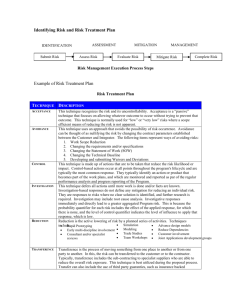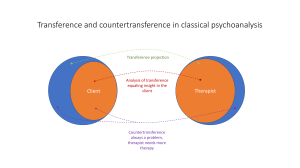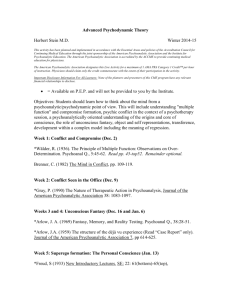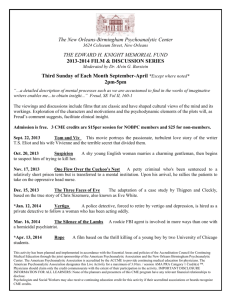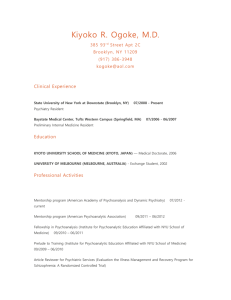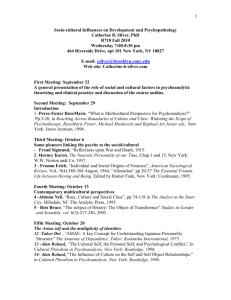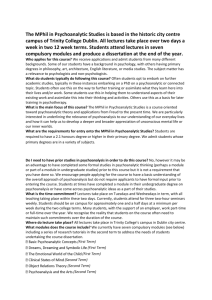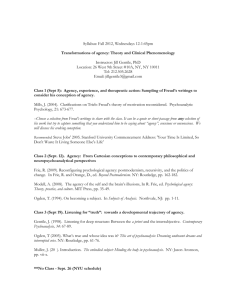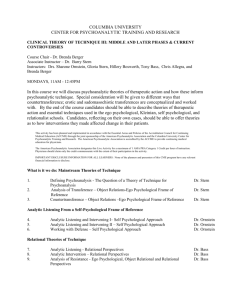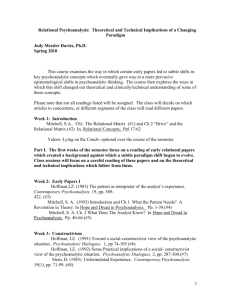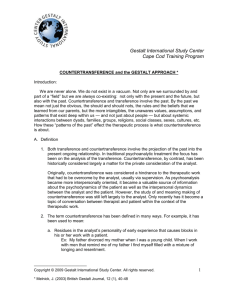Concerning "Transference," "Countertransference," and Other
advertisement
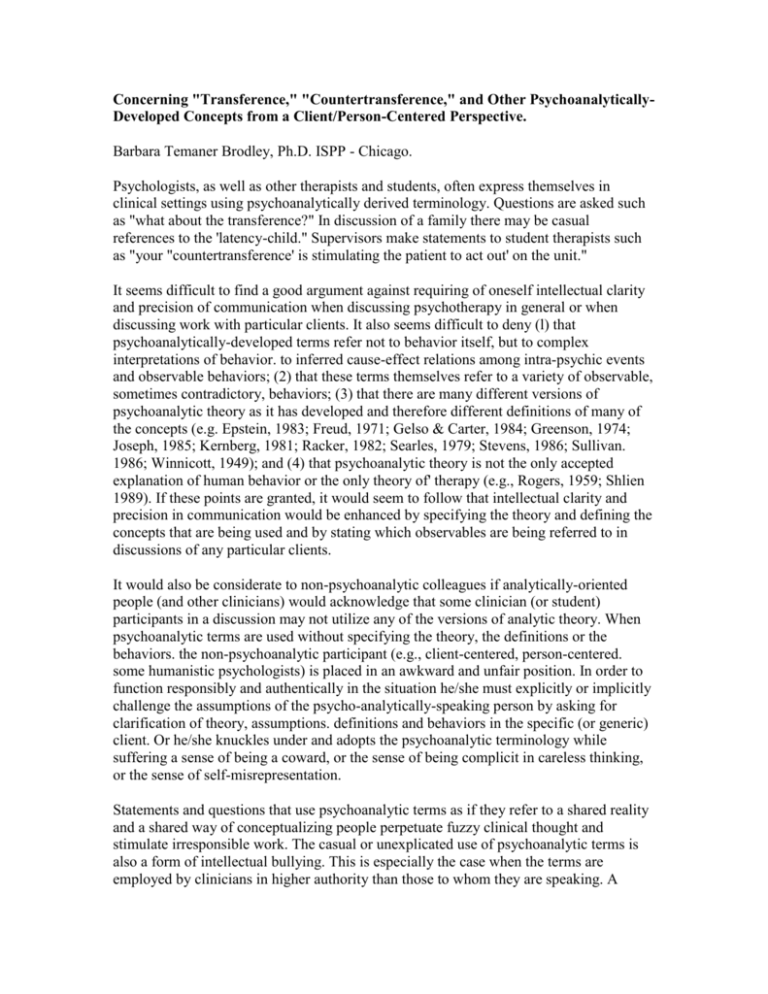
Concerning "Transference," "Countertransference," and Other PsychoanalyticallyDeveloped Concepts from a Client/Person-Centered Perspective. Barbara Temaner Brodley, Ph.D. ISPP - Chicago. Psychologists, as well as other therapists and students, often express themselves in clinical settings using psychoanalytically derived terminology. Questions are asked such as "what about the transference?" In discussion of a family there may be casual references to the 'latency-child." Supervisors make statements to student therapists such as "your "countertransference' is stimulating the patient to act out' on the unit." It seems difficult to find a good argument against requiring of oneself intellectual clarity and precision of communication when discussing psychotherapy in general or when discussing work with particular clients. It also seems difficult to deny (l) that psychoanalytically-developed terms refer not to behavior itself, but to complex interpretations of behavior. to inferred cause-effect relations among intra-psychic events and observable behaviors; (2) that these terms themselves refer to a variety of observable, sometimes contradictory, behaviors; (3) that there are many different versions of psychoanalytic theory as it has developed and therefore different definitions of many of the concepts (e.g. Epstein, 1983; Freud, 1971; Gelso & Carter, 1984; Greenson, 1974; Joseph, 1985; Kernberg, 1981; Racker, 1982; Searles, 1979; Stevens, 1986; Sullivan. 1986; Winnicott, 1949); and (4) that psychoanalytic theory is not the only accepted explanation of human behavior or the only theory of' therapy (e.g., Rogers, 1959; Shlien 1989). If these points are granted, it would seem to follow that intellectual clarity and precision in communication would be enhanced by specifying the theory and defining the concepts that are being used and by stating which observables are being referred to in discussions of any particular clients. It would also be considerate to non-psychoanalytic colleagues if analytically-oriented people (and other clinicians) would acknowledge that some clinician (or student) participants in a discussion may not utilize any of the versions of analytic theory. When psychoanalytic terms are used without specifying the theory, the definitions or the behaviors. the non-psychoanalytic participant (e.g., client-centered, person-centered. some humanistic psychologists) is placed in an awkward and unfair position. In order to function responsibly and authentically in the situation he/she must explicitly or implicitly challenge the assumptions of the psycho-analytically-speaking person by asking for clarification of theory, assumptions. definitions and behaviors in the specific (or generic) client. Or he/she knuckles under and adopts the psychoanalytic terminology while suffering a sense of being a coward, or the sense of being complicit in careless thinking, or the sense of self-misrepresentation. Statements and questions that use psychoanalytic terms as if they refer to a shared reality and a shared way of conceptualizing people perpetuate fuzzy clinical thought and stimulate irresponsible work. The casual or unexplicated use of psychoanalytic terms is also a form of intellectual bullying. This is especially the case when the terms are employed by clinicians in higher authority than those to whom they are speaking. A student, for example, is unlikely to feel safe in challenging a supervisor's theoretical assumptions in the context of a clinical case discussion. Any instance of the usage of psychoanalytic terms in discussions about clients would be wisely countered with the questions: What precisely is the theory you are employing? What are your assumptions? What exactly are the definitions of the terms you are using? What specific behaviors of the client are you referring to? Unfortunately, this kind of questioning for clarification is rare. The mistake of using terms such as "transference" and "counter-t transference" as if they refer to consensually validated phenomena is not due entirely to the carelessness of clinicians and educators. It is carelessness at times. At other times it is due to ignorance and to poor intellectual education with respect to clinical psychology. But it is also, I suggest, the legacy of the high social status attributed to psychoanalysts and to the mystique of psychoanalysis promoted by its adherents. For reasons that have much more to do with the social history of the theory and practice of psychoanalysis than with the truth of the theory or the efficacy of the practice, terminology developed by Freud and other psychoanalysts has become the insider language of clinical psychologists and other therapists. rising terms such as "transference," etc., communicates an "insider" position to many people in the therapeutic community as well as to "outsiders." As a sign of status, the terms are used either as if they designate reality or as if the theory from which they are derived is valid. Neither is true. Psychoanalytic theory has not been proved. Nor has any other theory. The client/person-centered viewpoint concerning the concept of "transference," in particular, has been discussed by Rogers ([951:1987), and by Shlien (1984; 1987) and by Seeman (1987), Many of us who work from a client'person-centered framework do not find psychoanalytically developed terms useful. We not use them ourselves and when used by others we find them obfuscating. Some of us, also, experience these terms as offensive to our sensibilities and to our feelings of humility and respect towards our clients and towards persons in general. Whether or not a therapist or instructor subscribes to a version of psychoanalytic theory or practice, it should be obvious that sincere efforts to truly understand and to work effectively with clients or patients would be enhanced by intellectual clarity and openness of communication with colleagues and students. Deliberately avoiding psychoanalytic terms (at least until after discussion has taken place to specify behaviors, to explain theory and to define terms) would be a practice likely to lead to bet communication with colleagues, to better understanding of clients and to more effective practice. References Epstein. L. (1983). The therapeutic function of hate in the countertransference. In L. Epstein & A. H. Feiner, (Eds.). Countertransference: The therapist's contribution to therapeutic situation (pp. 213-234). New York: Jason Aronson. Inc. Freud, S, (1974). Letter from Freud to Jung dated 1909. In W. McGuire (Ed.); The Freud-Jung letters (p.231). Princeton, NJ: Princeton University Press. Gelso, C. 3., & Carter. J. A. (1984). The relationship counseling and psychotherapy: Components, consequence and theoretical antecedents. Counseling Psychology, 1, 155237. Greenson, R. (1974). Loving, hating and indifference towards the patient. International Review of Psychoanalysis, 1, 259.166. Joseph, B. (1985). Transference:. The total situation. International Journal of Psychoanalysis, 66, 447-454. Kernberg. 0. (1981). Countertransference. In R. Langs (Ed.), Classics in psychoanalytic techniques (pp.207-216). New York: Jason Aronson, Inc. Racker, H. (1982). Transference and countertransference. New York: International Universities Press, Inc. Rogers. C. R. (1951). Client-centered therapy. Boston: Houghton Mifflin Co. Rogers, C. R. (1987). Comment on Shlien's article "A countertheory of transference." Person-Centered Review, 2,182-188. Searles. H. F. (1979). Countertransference and related subjects: Selected papers. New York: International Universities Press. Stevens, B. (1986). A Jungian perspective on transference and countertransference. Contemporary Psychoanalysis, 22.185-201. Seernan, J. (1987). Transference and psychotherapy. Person-Centered Review, 2, 185195. Shlien, J. M. (1.984). A countertheory of transference. In R. H. Levant and J. M. Shlien (Eds.), Client-centered therapy and the person-centered approach (pp. 153-181). New York: Praeger. Skinner. B. F. (1989). Dialogue with Cart Rogers. In H. Kirschenbaum and V. L. Henderson (Eds.), Carl Rogers: Dialogues (pp. 79-152). Boston: Houghton Mifflin Co. Sullivan, B. S. (1987). The disliked client. Quadrant. 2, 55-71. Winnicott, D. W. (1949). Hare in the countertransference. International Journal of Psychoanalysis, 3,69-74.
